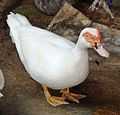Mulard
.jpg)
The Mulard (or Moulard) is a domestic duck hybrid of Pekin and Muscovy ducks. The mulard, therefore, is not just a hybrid between different species, but between different genera: the Muscovy is (Cairina moschata) whereas the Pekin is descended from the Mallard (Anas platyrhynchos). Like many inter-specific F1 hybrids, mulards are sterile and are commonly called "mule ducks". They can be propagated by mating male muscovies with female pekins, but most are produced by artificial insemination.
Strictly speaking, by analogy to hybrids between horses and donkeys, the term Mulard or Moulard should be reserved for offspring where the parental drake is the Muscovy, and the duck the pekin. When the drake is the pekin, the offspring tend to be smaller and are called hinnies.
Husbandry and Production
The Mulard is commercially produced on farms for meat and foie gras. The white Muscovy and Pekin are the two most common purebred, commercially farmed ducks. Hybrids of the two are hardier and calmer, in addition to exhibiting natural hybrid vigor.[1]
The incubation period of the hybrid eggs is between the Mallard and Muscovy, with an average of 32 days. About half of the eggs hatch into mulard ducks.[citation needed] Mulards tend to combine certain traits of the parent breeds. Due to their Muscovy heritage, they produce leaner meat than Pekins; females tend to be raised for meat while males are used for foie gras. Like Muscovy ducks, mulards have claws on their feet, but do not fly and perch; instead, they prefer to stay on water, as Pekins do.[2]
Traditionally, foie gras was primarily produced with geese, but in the 1960s the majority of farmers began to use mulards. Geese are more expensive to maintain than ducks (they are larger and more aggressive), and the more temperamental Muscovies did not accept the process of gavage (force feeding) as readily as Pekins, causing the quality of the foie gras to suffer.[2] This problem was avoided by the introduction of mulards. These hybrids have also become extremely common in countries where foie gras is not produced.[3]
Today in France, the leading foie gras producer and consumer, the use of hybrid ducks outnumbers the use of geese. In 2007, there were 35 million mulard ducks raised in the country, compared with only 800,000 geese.[1] In addition to Europe and the United States, mulards are widely raised throughout Southeast Asia.[3]
Gallery
-
Muscovy Duck
-

Pekin drake
-

Moulard Duck Foie Gras with Pickled Pear
See also
References
- ↑ 1.0 1.1 Caro, Mark (2009). The Foie Gras Wars. Simon & Schuster. ISBN 978-1-4165-5668-8.
- ↑ 2.0 2.1 "Committee on Animal Health and Animal Welfare on Welfare Aspects of the Production of Foie Gras in Ducks and Geese". European Commission. December 1998.
- ↑ 3.0 3.1 Daghir, N. (2008). Poultry Production in Hot Climates. CABI. ISBN 978-1-84593-258-9.
